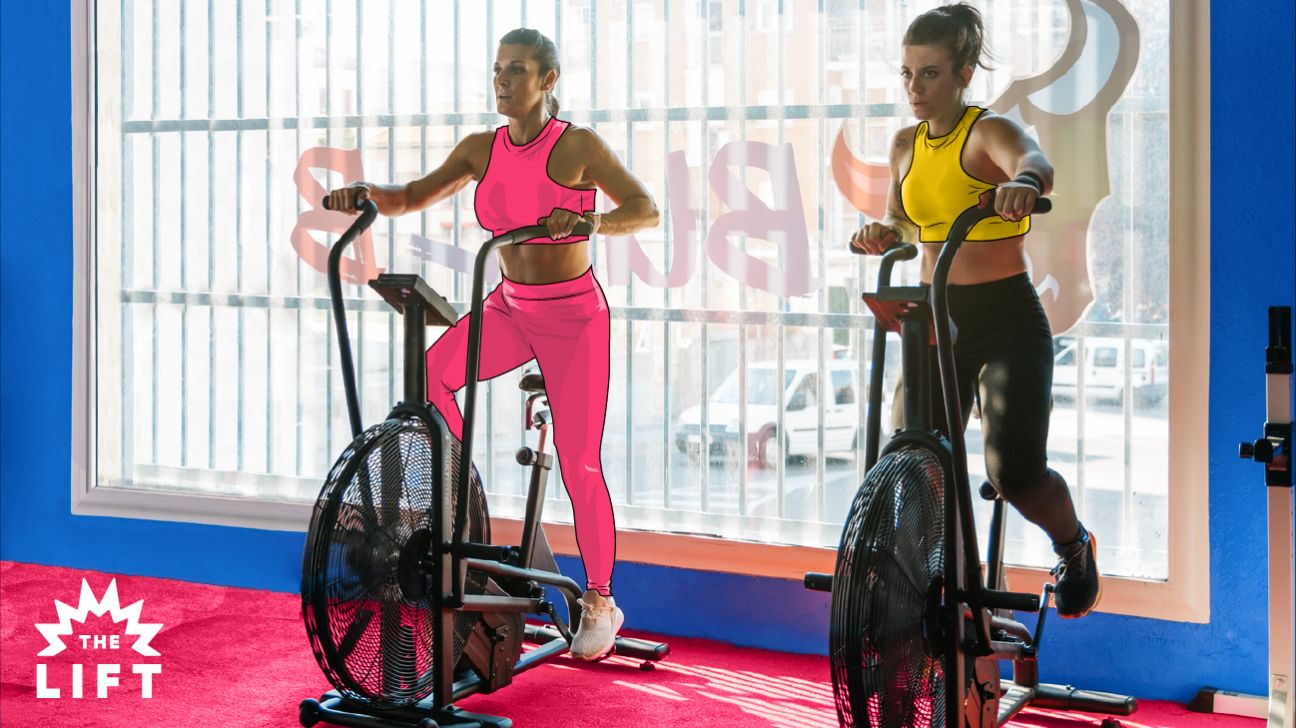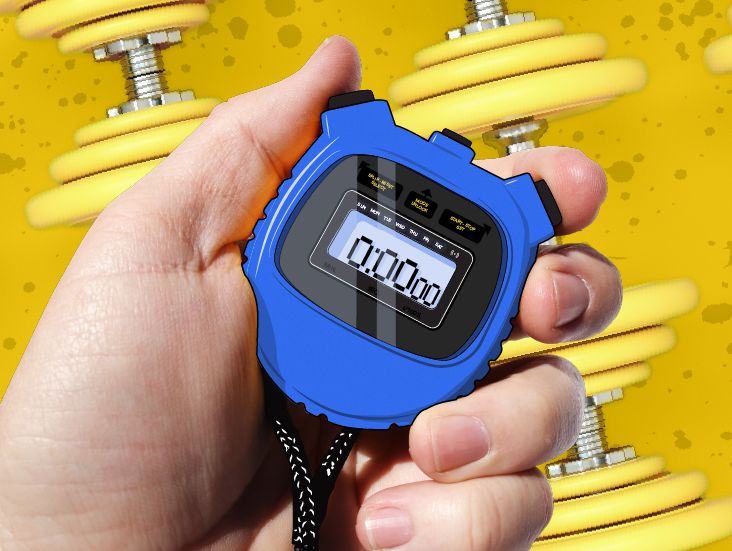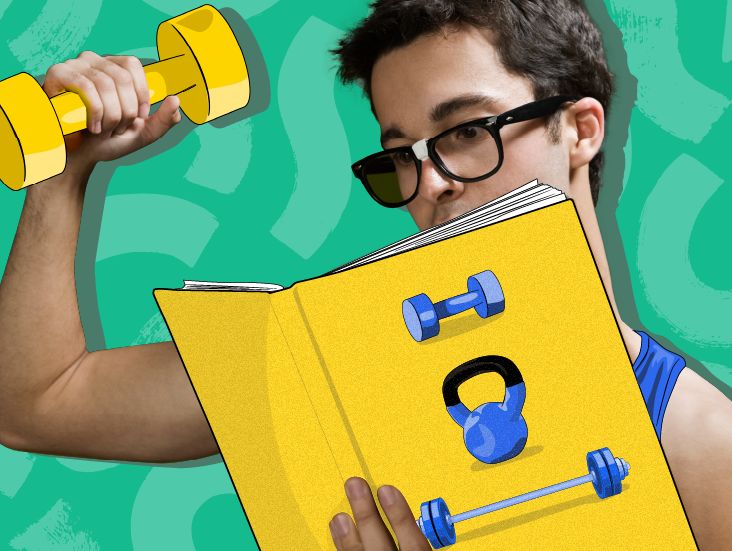So you want to try an air bike workout?
The name “air bike” might make this subcategory of stationary bikes sound easy and breezy — but then you look at the fact that the bestselling air bike of all time is dubbed the “AssaultBike.” That should be a not-so-subtle clue that yes, it does feel like an assault on your muscles.
Powered entirely by the air you pump through the front fan, these bikes are the exact opposite of a breeze.
John Gardner, NASM-certified trainer and CEO of Kickoff, explains: “The more you pedal, the more wind resistance is created from the fan, making pedaling even more difficult.”
Luckily, what air bikes lack in ease, they make up for in effectiveness.
Below, coaches and trainers break down the health and fitness benefits of climbing aboard an air bike — plus, we share tips for incorporating the tool into your workout routine.
First off, air bikes are *not* like the Peloton, which is souped-up with gizmos and gadgets, on-screen instructors, and hand weights.
(TBH, air bikes look pretty grunge compared to the at-home cycling bikes that made big waves in 2020.)
Air bikes are similar to regular ol’ stationary bikes but have handles that move in sync with the pedals — kinda like the love child of an indoor bike and an elliptical. And instead of a flywheel, these bikes sport a ginormous fan up front.
Keep in mind that while there are four power generation points (two pedals + two handles), you don’t have to use all of them at once! You have the option of resting one or both of your feet on the structural footrests. And you can choose not to use your arm(s) if desired.
This makes the assault bike a great option for:
- injured athletes
- older folks
- adaptive athletes
- people new to cardiovascular exercise
Given that using an air bike incorporates your arms, too, it should come as no surprise that these devices engage nearly every muscle, from head to hands to hooves.
According to Gardner, air bikes require extra oomph from your:
- hamstrings
- quadriceps
- calves
- core
- biceps
- triceps
- glutes
- hip flexors
- chest
- back
- shoulders
In practice, that means the air bike can be used to build muscular endurance in any and all of those muscle groups. (Pretty impressive, right?)
It also means that, when ridden at a lower intensity, the air bike can be an effective way to warm up your muscles before a workout.
The air bike also strengthens your heart
“Riding the air bike can 100 percent improve your cardiovascular capacity,” says certified personal trainer Robert Dodds, Founder of Nothing Barred Fitness.
“Because you’re working your lower and upper body at the same time, your heart has a number of body parts it has to pump blood to,” he explains.
Not only does the bike improve cardiovascular capacity, but it does so better than many other types of equipment. Really!
“The air bike is a superior cardio machine compared to other approaches, because it’s low impact and therefore not stressful for your joints (the way running and sprinting are),” Dodds says.
For the most part, how you ride an air bike will be pretty intuitive. But, as Dodds puts it, “using an air bike is a specific skill, as is everything.”
And assuming you don’t want to get sidelined by injury or aches, you’d be wise to learn that skill before starting.
Here are a few form tips he recommends for before and during the ride:
1. Set the seat
Make sure to adjust the seat to hip height.
For most people, this is the height that will allow you to pedal without your legs being placed in either a locked-out position or an excessively bent position, which is ideal.
2. Sit upright, with core extended
You shouldn’t look like the Hunchback of Notre Dame when taking on this cardio tool.
Once on board, think about sitting upright. This will not only make it easier to get air into your body but also give you way more distance to push and pull the handles than you’d have if you were bent forward.
3. Control your knockers
Of course, what you do with your legs matters too. If you try to use only your upper body during an air bike workout, you’ll tucker out wayyy faster.
Dodds’ suggestion: Think about keeping your knees in one straight line rather than letting them flare butterfly-style at the top of each rotation. This will allow you to apply maximum force to the pedals and thus increase your power output.
Three cheers for efficiency!
Reading an air bike screen
Start pedaling an air bike and you’ll immediately notice that there are so (!) many (!) metrics (!). Here’s a rundown of what you’ll see and what it means:
- Time: self-explanatory
- Calories: (estimated) number of calories burned
- Revolutions per minute (rpm): perceived rate of exertion
- Watts: a measurement of the power you’re producing
- Miles: estimated distance traveled (if on land)
“Increasing any of these metrics over time will mean that you’re getting fitter,” says Dodd.
But the one you’ll want to focus on primarily will depend on your fitness goals. If you want to improve your power output, then you should keep your eye on watts or rpm.
“If you want to develop steady-state endurance, then time or distance should be the metric you’re focused on improving,” says Dodds.
But he also notes that as you focus on metrics, it’s important to peek at your rpm from time to time. “You want your average power output to remain consistent or improve as you get further into your workout,” he says.
Otherwise, you’re probably not working as hard as you think (or feel).
How you choose to incorporate this cardiovascular machine into your routine will depend on your exact fitness goals.
As a general rule, cycling expert Will Henry, founder of Bike Smarts, an online hub for biking expertise, recommends new riders start off doing 10–15 minutes on the air bike at a light to moderate pace and then cooling down. This will give you a sense of how to operate the device and allow your body to gauge how taxing it can be.
Next time, you might add 2 additional minutes and slowly increase, workout by workout, until you get to a total of 20–30 minutes.
Once you’re comfortable using the machine, you might try doing a workout like 200 calories for time or max calories in an hour.
If you’re a HIIT lover, you might take a page from the functional fitness playbook and do one of the following infamous CrossFit WODs:
Death Race
5 rounds for time:
- 10–15 calories on the air bike
- 10 burpees
It’s a Trap
Every 5 minutes, perform 30-second intervals of max calories for 5 rounds.
30 seconds of work and 30 seconds of rest per interval.
The Climb
Repetitions of 9-15-21:
- calories on the air bike
- handstand push-ups
No matter what air bike workout you try, “Don’t be too hard on yourself or disappointed if you’re struggling to keep up,” says Gardner. “When it comes to the air bike, consistency is key.”






